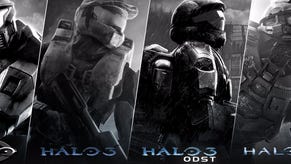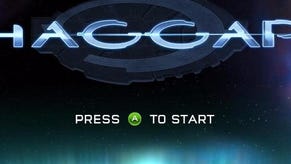Halo 4 review
Truth or reconciliation?
It's the end of Halo 3 and the world has ended with a bang, not a whimper. More specifically, it's ended with our protagonist Master Chief riding a jeep off a flaming planet into the bay of a derelict escape ship: a catastrophic boom, not a whimper, perhaps. The aliens retreat, the flames turn to ember, the hoarse choir sets down its sheet music and space is, finally, still. Microsoft's flagship trilogy ostensibly drifts into history while developer Bungie, after working out its contractual obligations, wanders off to work on something new - something to prove to itself that Halo, the console shooter that changed everything, isn't the end of its story.
Master Chief, though, has nowhere to go. He has no home for Christmas, no lonely wife to reacquaint with, no overgrown garden to tend to, no son to teach how to throw a plasma ball. Beneath the rank and uniform he may be named John, but that ever-present helmet snuffed out the pilot light of his humanity long ago. He is a voiceless weapon, drawn in times of intergalactic crisis, sheathed when calamity has passed. So he's left in stasis, a dreamless sleep in a forgotten ship watched over by his only friend and companion, an AI girl called Cortana.
Five years pass - an age in video games - and in this time Activision's Modern Warfare series rises to prominence, knocking Halo down the most-played charts. A time of crisis; a time for an old hero to take back old ground. It's the start of Halo 4, and Cortana unsheathes Master Chief.
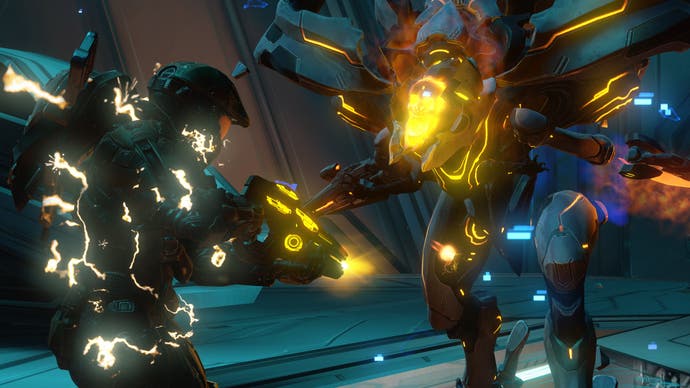
But while this one-man army has renewed purpose and a new crisis to tackle, that lack of humanity is hidden in plain sight. For a game so focused on saving the universe, the Halo series is curiously devoid of people to save. It's filled with others to destroy, of course, this time in the form of the Prometheans, an alien race of bipedal insect knights and exploding robot dogs that fight against (and alongside) Halo's more familiar enemies, the Covenant.
They provide the ingredients for the sprawling three-way battles the series is known for and - while their ability to warp and fly is an irritating combination - in their assured design new developer 343 Industries shows that it's up to the task of expanding the boundaries of the Halo universe. And it's a universe filled with weapons, more weapons than ever before, the Prometheans adding their armoury of esoteric rifles and machine guns to the already enormous array of killing tools. But people to save? You won't find many of those here.
You can save yourself - but with instant restarts and checkpoints, death is a setback that can be measured in short seconds and the stakes are necessarily low. You can save your comrades, the nameless cannon-fodder marines that accompany you into the fray from time to time. But when their passing goes unnoticed, either by the game's story or its systems, there's precious little motivation to take a bullet for these ciphers.
Which begs the question: why? When the only people you meet in your relentless dash from Pillar to Outpost are high-ranking military officials or untrustworthy scientists, where's the motivation? Why not let the aliens rule this space junk, these empty planets, these clinically clean ships? There doesn't appear to be anyone else around to protest anyway.
"You must save Cortana but in the end it's Cortana who saves Halo 4."

Not for the first time, Halo's scriptwriters turn to Cortana for the answer: Master Chief's luminous AI companion, the damsel-in-distress within. Her voice has always been the steady hand on Halo's tiller, guiding the player through space and time - a mostly reliable narrator who offers exposition at every turn and, most importantly, brings a human voice into a soundscape otherwise filled with explosion and death.
Cortana is dying. More accurately, she is descending into rampancy, a form of AI Alzheimer's. Her deterioration - wonderfully articulated by actress Jen Taylor - is the driving force behind a story that is otherwise bulky but weightless, a tower of myth devoid of meaning. So you must save Cortana but, in the end, it's Cortana who saves Halo 4. In a story in which you play the role of a weapon trying to save an absent people, she provides a whisper of motivation in a chamber of emptiness, a touch of love in a universe of bullets. Cortana answers the question why, even as the rest of the game's bloated narrative struggles to say anything at all.
The four years of stasis have brought more than just the decline of Master Chief's only friend. Modern Warfare's influence has somehow seeped into Halo's feel and aesthetic. It's in the beginning, as you haul yourself up an elevator shaft on the crumbling Forward Unto Dawn ship, dodging incoming projectiles with QTE-lite inputs. It's in Master Chief's iconic suit, now Teflon-coated like Sam Fisher ready for a night on the tiles. It's in his weight, still unmistakeably floaty when you jump but heavy-footed when you run. It's in the tactical packages dropped into multiplayer when you score the requisite kill streak, and in the perks and customisable dog-tags: all the borrowed trappings of Infinity Ward's success added to the Halo recipe. It is, most obviously, in the control scheme, which for the first time allows you to discard your Halo muscle memory in favour of Modern Warfare's, aiming down the iron sights with a squeeze of the left trigger.
"It's a beautiful game, with none of the garish colours that spoiled the remake of Combat Evolved last year. Halo has never looked better."
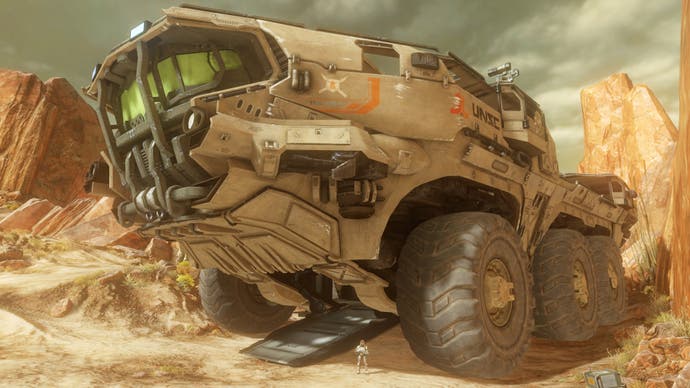
But if Infinity Ward's presence is felt in the details, the broad sweep of 343's Halo 4 is still pure Bungie. It's a beautiful game, with none of the garish colours that spoiled the remake of Combat Evolved last year. From lush, swampy foliage to craggy bronze mountains, Requiem - the planet on which much of the game takes place - presents diverse, picturesque landscapes. Halo has never looked better. And the moment-by-moment play has all of the recognisable satisfaction: the meaningful choices of what items to take and what to leave behind defined by the two-weapon limit, the rhythms of advance and retreat defined by the recharging shield. Halo's old inventions, untouched, distinguished.
Nevertheless, your assigned tasks are over-familiar. Much of the game is spent racing from one location to the next in order to press some crucial button or to destroy some important shield generator. These objectives always come in threes, the repetition artificially extending the length of what is a somewhat short campaign. 343's eagerness to show that it can impersonate the Bungie touch is so overwhelming that there's little room for novelty. A driveable bipedal robot dubbed the Mantis is the most obvious invention, aside from the Prometheans and their guns, but elsewhere the developer handles the universe conservatively, as if hoping to learn imitation before attempting true extension - at least in the single-player campaign.
In competitive multiplayer, by contrast, there is a tightened focus: evidence of Microsoft's desire for Halo to be taken more seriously in the eSports arena. Load-outs are more important than before, with far fewer guns available on the battlefield for collection. Rising up through the rankings unlocks new weapons, perks and armour options, many of which have tangible competitive benefits (such as the ability to run indefinitely or to deploy a sentry turret). It's undeniable that multiplayer Halo has lost some of its purity in this fashionable move - although the playing field will even out after a few weeks when dedicated players have unlocked all of the perks.
"Halo 4 is authentic, and assures 343's role is more than a mere tribute act."
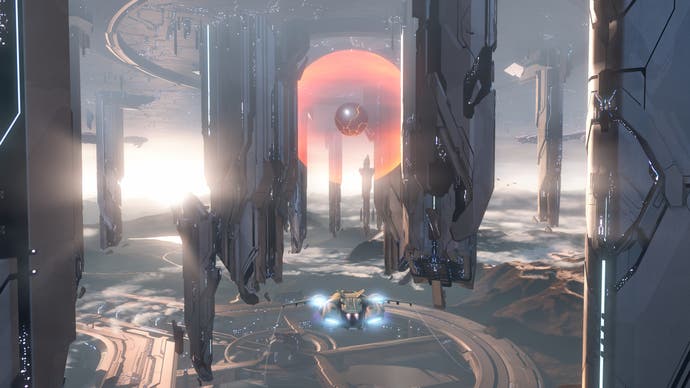
Spartan Ops, another import from Modern Warfare, offers Halo 4's most ambitious post-launch framework for on-going adventure. A series of discrete 15-minute missions for up to four players, each with an accompanying short film that develops the story, will be released in weekly instalments over the coming months. The five missions that comprise episode one are available at launch, providing yet more co-operative engagement for friends, this time with badges and meta-objectives to keep you playing. In their straightforward simplicity these missions offer some of the most enjoyable co-op moments in the game - an example of 343 sensitively folding new influences into the Halo mix.
At the end of Halo 4's campaign, after the credits have rolled, 343 Industries posts a short message thanking fans for trusting the company with their beloved universe and asking us to remember that this is just a first step. It's a telling memo that reveals a certain nervousness about the task at hand: a plea that we understand the weight of responsibility these creators have felt in adopting Master Chief.
They can rest easy. Halo 4 is authentic, and assures 343's role is more than a mere tribute act. Their delicate yet sprawling work may be more continuation than true expansion - and perhaps the true test comes in the next step - but for now, Halo returns with a bang, not a whimper.




